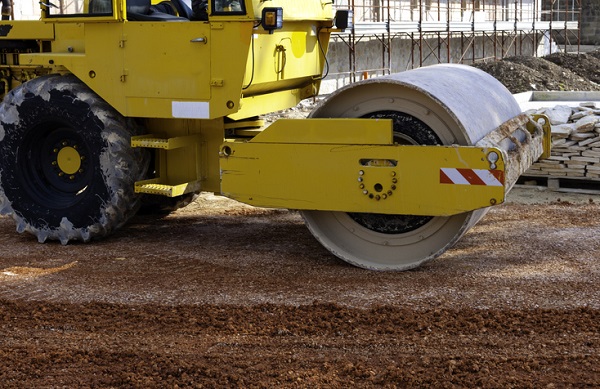Improperly compacted structural fill material is the #1 cause of residential structural failures. It can be a builder’s worst enemy, more so than expansive or soft organic soils, improper drainage, or poor engineering or framing practices. What does that mean, how does that happen and what can you do to avoid it?
What Is Structural Fill Material and How Does It Cause Structural Failures?
Structural fill material is an earthen material builders use to create a strong base for the homes they build. This is especially important in areas where the native soil may be weak. Since 80% of structural claims stem from soil movement, having properly compacted structural fill can help reduce such problems.
How Does Structural Fill Material Become Improperly Compacted?
According to Walt Keaveny—Risk Manager and Principal Engineer with 2-10 Home Buyers Warranty (2-10)—using structural fill material of poor quality or insufficient density is a leading cause of improperly compacted structural fill material. When choosing structural fill material for your construction, you should make sure that it’s the right quality and density for the soil you’re building on (more on that in a bit).
Another cause of improperly compacted fill is when builders purchase land from a developer that has existing fill in place. When developers sell land to builders, they usually sell it as is. This means that if you buy land where fill exists and whoever put it there didn’t disclose it or assure they compacted it properly, you could be liable for any problems that existing fill causes.
A final leading cause is the heavy machinery you may use to compact the fill itself. Keaveny notes that while bulldozers and front-end loaders are useful for placing the fill, they aren’t heavy enough to compact it properly. That’s because bulldozers and front-end loaders are designed to move in ways that prevent them from getting stuck, rather than to compact soil.
What Are the Consequences of Improperly Compacted Fill?
Improperly compacted fill can be a disaster for you and your buyers, leading to structural failures. If you use fill that’s low quality or of improper density, it may consolidate. This can cause the soil to settle too much, which can induce heavy damage to the home’s foundation, framing and interior finishes.
Additionally, improperly compacted fill can cause a domino effect of destruction due to contact with excessive amounts of water. According to Keaveny, newly constructed homes often experience over-irrigation for the sake of the landscape. They also tend to have concentrated roof-drainage systems. When this excess water interacts with improperly compacted fill, it can cause further consolidation and saturation, which makes the fill even weaker and threatens the home’s structural integrity.
It doesn’t take too much improperly compacted fill to cause problems. Even a foot of improperly compacted fill can cause catastrophic problems, since many foundations lie on top of this fill. And according to Keaveny, the average cost to investigate and repair a qualifying fill claim is about $50,000, not to mention the negative impact such problems can have on a builder’s reputation.
You Build it, We'll back you up.
Learn why 1 in 5 new homes nationwide are covered by a 2-10 HBW Structural Warranty.
How Can You Avoid Improperly Compacted Fill?
Here are some steps you can take to assure that you’re compacting your fill material properly. Avoiding problems with fill can protect your budget and reputation.
First, always make sure that the fill material you use is the right quality and density. A good way to do that is to work with a geotechnical engineer who can confirm the appropriate quality and density for the soil you’re building on. Working with a geotechnical engineer can also help you avoid problems like slope failures, retaining wall failures and drainage problems, which can arise from improperly compacted fill.
Next, always check any land you’re considering buying for development for existing fill. Sometimes, existing fill goes undocumented. And of course, be sure that any fill you place has the correct density and compaction. You’re likely already doing this, as there are countless best practices and requirements from governing bodies that urge builders to do so.
Finally, be sure to use the right machinery to properly compact your fill. Recall that bulldozers and front-end loaders aren’t built to compact your fill. Instead, you’ll want to use a soil compactor to properly compact the fill. You should also commit to density testing after you compact your fill. This is another great reason to work with a geotechnical engineer, as they and their representatives can test, confirm and document that you compacted your fill properly. This can greatly reduce your liability.
Keeping Structural Failures at Bay
Though improperly compacted fill is the top cause of residential structural failures, it’s also avoidable. A good place to start is by following the steps above. An even better strategy is to complement those steps with an industry-leading 2-10 Structural Warranty.
A 2-10 Structural Warranty protects against structural issues caused by soil movement. It also does much more. 2-10 Builder Members get access to experts who can help you avoid problems like unexpected soil movement. Our experts know the soils and problems they can cause in each of the states we serve.
A 2-10 Structural Warranty protects your profit by transferring your liability for structural damage to us. It promotes your quality and differentiates your homes in the market. And it lets you move forward with confidence knowing you’re controlling what’s behind you. Whether you’re trying to avoid the #1 cause of residential structural failures, trying to protect your profit or differentiate yourself, 2-10 can help, because when you build it, we back you up.
Special thanks to Walt Keaveny, whose expertise inspired this article.








